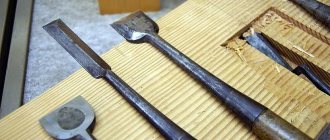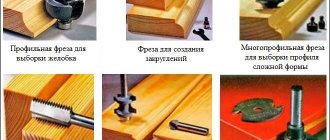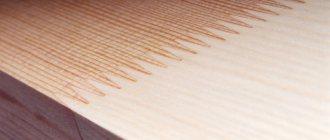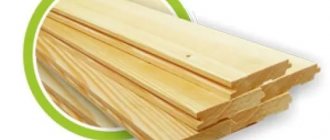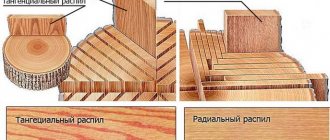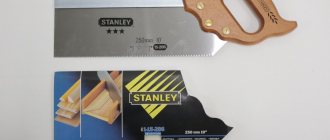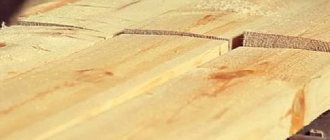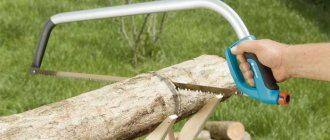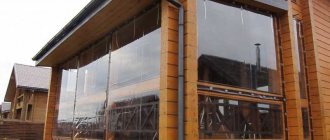The process of manufacturing furniture, windows, doors or finishing materials from wood includes various types of processing of wood and other wood-based materials (chipboards, laminated chipboards, MDF, fiberboard, OSB, plywood). Mechanical processing with special woodworking tools occupies a significant place among them.
Mechanical processing of wood and wood materials can be carried out in violation of their integrity (destruction of wood fibers) - cutting, planing. And also without destroying the fibers - pressing, bending.
Wood cutting is a mechanical processing process in which wood is divided into parts in a certain direction. Cutting, in turn, can be divided into two subtypes - without chips and with the formation of chips and sawdust. In the first case, this is splitting, stamping, cutting with guillotine shears. In the second, the impact on wood with the cutter (cutters) of a woodworking tool is sawing, planing, milling, drilling, as well as grinding.
It is for this subtype of mechanical processing of wood and wood materials that our company offers woodworking tools (circular saws, band saws, mounted cutters and conical cutters, as well as drills).
Cutting elements. Basic concepts and definitions
A workpiece is an object subject to changes in shape, size and roughness.
After completion of machining, a product (processed part) is obtained from the workpiece, i.e. subject of labor.
The theory of wood cutting appeared in 1870 (founder I.A. Thieme).
Cutting is the technological process of breaking the bonds between particles of the workpiece material along the design surface with the blade of a cutting tool in order to obtain a product (part) of the required shape, size and roughness.
Cutting is an action aimed at changing the shape, size and roughness of an object of labor when performing a technological operation by cutting.
Blade is a wedge-shaped element of a cutting tool. It is designed to penetrate the workpiece material and separate the cut layer.
Cutting processing carried out with a blade tool is called blade processing (GOST 25761–83). If cutting is carried out with abrasive grains, the processing is called abrasive. Abrasive grain is a particle of abrasive material with an irregular shape and linear dimensions not exceeding 5 mm.
Scheme of blade wood processing
The diagram (Fig. 1) shows the workpiece 1 being processed, the blade 4, which moves along the design surface 6, penetrates the workpiece material and separates the cut layer 2. The cut layer is characterized by length l, width b and thickness a. The wood of the cut layer in its entire volume is elastically-plastically deformed, twisted, and destroyed. This part of the material 5 is usually called chips.
Part of the wood specially left for removal during this operation and called allowance P. In some cases, allowance P can be so large that it is not cut off immediately, but sequentially in several passes. Allowances are provided in the workpiece on all sides. After removing the allowances, part 9 is obtained.
Rice. 1. Schemes for blade processing of wood: a – planing; b - milling
The surface 3 of the workpiece that is subject to change during the cutting process is called the machined surface. The surface 7, obtained again during the next pass of the tool, is called processed. It coincides with the design surface 6. The intermediate surface 8, which temporarily exists during the cutting process between the machined and machined surfaces, is called the cutting surface. The latter is always in contact with the blade.
Choosing a wood species
Wood for carving is most often softwood lumber. Coniferous varieties are in great demand because they contain a large amount of resin. Resins make the material more weather resistant. Coniferous wood for carving is used of any age.
Of the deciduous varieties, linden is the most popular. You need to choose a tree that is more than 70 years old. Poplar is suitable for this purpose at the age of 50 years.
Main types of timber:
- Linden, despite its hard structure, is quite easily processed with a cutter. Since this raw material is characterized by a fine-fiber structure, experienced craftsmen can create fine patterns and complex designs. In addition, linden has a rather attractive even white shade.
- Aspen has a uniform structure, but is rarely used for carvings because it has an extremely resistant green tint that can ruin the decoration
- alder is characterized by dramatic color changes. Freshly cut raw materials are smooth white in color, but when exposed to open air they turn red very quickly. After this, over a period of time, the color fades and becomes pale pink. Experienced craftsmen often use this feature of alder, because by insulating the workpiece in a timely manner, they can achieve the desired color of the material, which is suitable for the chosen pattern
- Birch is distinguished by its white color with a yellowish tint. The structure is homogeneous and quite viscous. The resulting products have high strength.
Cutting wood involves using more than just the wood itself. Quite often the so-called mouthguards and suveli are used. A burl is a characteristic growth on a tree trunk, often found in its root part. The burl has the same density as a tree trunk. However, its texture is much more varied; there are quite bizarre inclusions.
Suvel is a growth that covers a tree trunk in a circle. When removing the suvel, you must be very careful not to disturb the structure. However, the result is definitely worth the effort because the suveli cross section has a uniquely beautiful curved texture.
Classification of wood-cutting tools. Materials for cutting tools
All wood-cutting tools are divided into manual and machine, and according to the method of fastening on the machine - attachment and tail.
Hand-held wood-cutting tools include various saws, axes, chisels, chisels, knives (pieces of iron) for sherhebels, planes and hand jointers. The machine-made wood-cutting tool (Fig. 2) is complex in design: depending on the type of mechanical processing of wood, the following is used:
- in circular saws - circular saws (a);
- in planing – planing knives (b);
- in milling - shaped cutters (c), end cutters (d);
- in drilling machines - drills (e, f), countersinks (g), chisels (h), etc.
Based on the material from which the blades are made, the tool is divided into the following types:
- steel cutting tool;
- high-speed cutting tool;
- carbide cutting tools;
- mineral ceramic cutting tool;
- diamond tool, its blades are made of synthetic diamonds or polycrystals of cubic boron nitride.
Rice. 2. Wood-cutting machine tools: a – circular saw; b – planing knife; c – shaped cutter; d – end mill; d, f – drills; g – countersink; h – bit
For the purpose of uniform preparation of technical documentation in production, mechanical engineering standards have established a decimal system of classification and digital designations of tools and devices.
A unified system for designating technological equipment is used in technical documentation, when marking products, filling out applications, accounting and storing products.
Requirements for the material
The material of the cutting tool must provide such a combination of properties that the tool works equally well both in the initial running-in stage of wear and in the subsequent stage of monotonic wear. The following requirements apply to the material:
- strength , which reduces running-in wear and ensures performance when cutting thick layers of wood;
- high fatigue strength providing the ability to resist cyclically changing contact loads;
- plasticity , necessary for performing a number of operations to prepare the tool, for example, setting, flattening saw teeth, etc.;
- hardness , which determines the resistance of the metal to abrasion;
- heat resistance , ensuring that mechanical properties remain unchanged when heated;
- resistance against corrosion , creating the ability to process raw wood when the blade is subject to electrochemical corrosion.
Thus, the material of the wood-cutting tool must be durable, ductile, hard, heat-resistant, and resistant to corrosion. These properties are possessed by tool steels (high-quality, high-quality, alloyed, high-speed) and hard alloys (cast, tungsten-cobalt, synthetic superhard materials based on boron nitride, polycrystalline diamond alloys).
Compared to alloy steels, hard alloys can increase the service life of the tool. Cast hard alloys increase the service life by 3...7 times, tungsten-cobalt - by 20...50 times, mineral-ceramic plates - by 200...250 times, PKA - by 300...1000 times.
Replaceable cutting inserts
In recent years, rotary cutting inserts, which have 2...4 cutting edges, have been widely used in milling heads. After one cutting edge has become dull, the plate is rotated and the tool works with the other sharp cutting edge. They are made of hard alloy for one-time use. After all cutting edges have become dull, the plates are not sharpened, but replaced with new ones. The cutting inserts are mechanically secured to the milling heads. To do this, they have mounting holes with which the plates are based on pins.
In Fig. Figure 3 shows examples of rotary cutting inserts. The profiles of the cutting edges of the inserts can be varied. Profile plates can be rotatable.
Rice. 3. Cutting plates: a – rotary; b - profile
BASIC EQUIPMENT OF A JOINER'S WORKSTATION WHEN PROCESSING WOOD WITH HAND TOOLS
In the carpentry industry, manual labor is still used in certain areas. For example, many operations are performed manually when repairing and restoring carpentry, especially furniture. Therefore, every carpenter, striving for ever greater mechanization of carpentry production and using every opportunity to achieve this goal, is at the same time obliged to have a good knowledge of the techniques of working with hand tools. When working with hand tools, the main equipment of a carpenter's workplace is a carpenter's workbench. The material being processed is fixed on the workbench, so the entire structure of the workbench is subordinated to the task of making work more convenient, productive and safe. The carpenter is required to always fasten the material being processed to the workbench correctly, firmly, and reliably. The workbench consists of a bench and a lid. Podverstache is usually made from pine. It consists of two racks connected to each other by longitudinal bars using a wedge connection. If the underbench becomes loose, it is strengthened by tamping wedges. Often a tool storage cabinet is built into the bench. The workbench cover is made from dry wood of oak, beech, birch, which is free from knots, cracks and other defects. The lid consists of a board 60-80 mm thick, tied with bars, a front clamping screw, and a rear clamping box. The lid must be precisely planed and covered with drying oil. In the cover, including the rear clamping box, through sockets are arranged parallel to the front edge, into which wooden or metal bench blades or combs are inserted. The blade is held in the socket by a flat spring. Blades and combs are used to clamp the material on the workbench in a horizontal position. In a vertical position, the material can be clamped with the front clamping screw and the rear clamping box. The boards are clamped in a horizontal position “on edge” with a front screw, while the free end of the board is supported on a stand. Workbench screws can be made of wood or metal. The best materials for wooden screws are considered to be elm and silver birch. A tray is placed in the lid of the workbench on the non-working side, in which small tools are held while working. The tray is often called a tool board. Manufacturing innovators have introduced improved workbenches. Vladimirov’s universal workbench and Kibasov’s workbench are especially famous. Vladimirov's workbench is equipped with a sliding lid, adjustable stops, folding stands and simplified clamps. It can be used as a clamp for compressing flat products. Kibasov's workbench is adapted for assembling window frames and door panels. It also has a sliding lid and movable stops. A carpenter sometimes has to set up a simplified temporary workbench. Such a workbench is made from sawhorses and planks, for which you should take planed boards with a thickness of at least 40 mm. Stops are placed on the flooring, and clamps are installed to secure the material being processed. The workbench is chosen according to your height. They do it like this. Facing the workbench, place your palms on its lid. If both palms are in full and sufficiently tight contact with the lid and the arms are not bent and the body is not tilted forward, we can assume that the height of the workbench is quite suitable for the worker. If the height of the workbench does not correspond to the height of the carpenter, you need to trim the racks of the bench from below or put strips on the racks from below. A carpentry workbench requires careful care and handling; you need to constantly monitor the condition of the bench and from time to time knock out wedges in the longitudinal bars, monitor the serviceability of the screws, and lubricate metal screws as needed. The workbench cover should be checked regularly; Having discovered warping, it must be eliminated immediately. Once a month you should cover the lid with drying oil. When drilling, cutting, through chiselling, you need to place a board under the workpieces so as not to damage the workbench cover. The cabinet has a special compartment for drawings, work orders and other technical documentation. Each tool must be stored in a cabinet in a specific place. Storing tools in bulk is prohibited.
* * *
A carpenter has to use various tools - basic (special) and auxiliary (general). The basic tool is discussed further in the relevant chapters. General purpose auxiliary tools include carpenter's hammers, pliers, wire cutters, pliers, round nose pliers, wrenches, and screwdrivers. This is mostly a metalworking tool, but a carpenter cannot do without it. Carpentry has special requirements for some auxiliary tools. For example, carpenter's hammers should be prismatic in shape with a smooth striking surface of the striker; A metalworker's round hammer with a convex head forms dents in the wood. The carpenter must have three hammers of different weights: 600, 400 and 200 g. The handles for the hammers are made from dogwood, birch, maple, beech, and hornbeam wood. A carpenter needs wrenches to screw in large faceted head screws (caps) and bolts. Screwdrivers are especially often required for screwing and unscrewing screws. The width and thickness of the pointed end should correspond to the spline groove (slot) on the screw head. A narrow or thin screwdriver damages the slot and the screw cannot be removed. Since different sizes of screws are used in carpentry, the carpenter must have several screwdrivers accordingly. A screwdriver with a double-sided insert is convenient: it is suitable for screwing in and unscrewing screws of various sizes. Quite often they work with a piece of screwdriver inserted into the brace. This technique makes the carpenter's work easier and increases productivity. Auxiliary tools also include files used for processing and cleaning parts in places inaccessible to other tools. There are rectangular, triangular, semicircular and round files. According to the size of the cut, files are divided into rasps, personal and velvet. Rasps have the largest notch in the form of pyramidal, staggered teeth-incisors. Personal and velvet files have a fine linear notch - single-row and double-row. The files are cleaned with a wire brush. You cannot clean by burning, as this will cause the notch to work faster. The carpenter's workplace should be organized in such a way that the carpenter, with the least possible expenditure of physical effort and time, produces as many products of excellent quality as possible. To do this, it is necessary to place the tool in the most convenient, always the same, order, which allows you to take the tool in one familiar and short movement, without wasting time looking for it. The fixtures should also be located with the greatest convenience. Small tools should be kept on a rack, and each of them should have its own permanent place. Tools and devices located at the workplace must be in full working order, adjusted and prepared for work. The workplace must be supplied with basic materials in a timely and uninterrupted manner and located in close proximity to the workbench, so as not to make unnecessary transitions and movements every time you have to take the material. Materials, tools, devices, work orders, drawings should always be obtained before work begins. Good illumination of the workplace and keeping it clean are of great importance. The given general guidelines for the rational organization of the workplace in each individual case of work are supplemented by special requirements depending on the type of operations, the equipment used and other conditions in which the work is performed. Special requirements are discussed in the relevant chapters.
Continuation of the book...
Woodworking machines
Machine types
Taking into account social needs and the scientific and technical level, woodworking equipment can perform four functions: technological, energy, management and planning.
If a technical device performs a technological function, then it is called a working machine.
A working machine is a mechanism or a combination of several mechanisms that perform certain appropriate movements to perform useful work. In the simplest case, all movements of the working machine are performed manually. For example, a gate for lifting water from a well, a drill for drilling holes, a meat grinder allow you to perform useful work and are manually driven.
Working machines that change the shape and dimensions of the workpiece by cutting are called machine tools.
Working machines that perform work using pressure are called presses.
Machines that perform work operations without changing the shape, size and quality of the object of labor are simply called machines (sorting, packaging, transporting, etc.).
Machines that carry out physical and chemical effects on the object being processed are called devices.
In order to facilitate the work of workers, increase productivity and improve the quality of products, a person transfers partially or completely other functions to the working machine: energy, management, planning.
If an energy function is transferred to the working machine (drive of the main movements, feed, etc.), then the machine becomes mechanized. Mechanization only reduces or partially relieves a person from heavy manual labor, since the control function (turning on, turning off, regulating the mode, loading and removing workpieces, etc.) still remains with the person.
If energy and control functions are transferred to a working machine, then it turns into an automaton and completely eliminates direct human participation in the work.
The machine independently performs all the working and idle strokes of the cycle according to a program previously compiled and debugged by a person. In this case, the working machine no longer replaces only muscles, but also, to a certain extent, the human brain. The person only has the function of monitoring, adjusting, preparing and replacing programs.
If the working machine is also given the planning function (selecting the desired program using a work planning system), then only the function of drawing up programs remains with the person.
If the energy and control functions are not completely transferred to the machine, then the working machine is called a semi-automatic machine. Typically, on semi-automatic machines, a worker manually installs, secures and unfastens the workpiece, and turns on the machine feed.
Lines
To perform technological operations, working machines are installed in lines, which can be in-line, automatic or semi-automatic.
A production line is a line of working machines located in the order of the sequence of operations of the technological process and requiring individual maintenance. The machines included in the production line may or may not be connected by vehicles. In a sawmill, for example, there are one or more production lines. The line machines are installed in a strict sequence of technological operations, and each machine is serviced by one or more workers. In this case, the machines are connected to each other by conveyors.
An automatic line is a system of machines located in a technological sequence, united by means of transportation and control, which automatically performs a set of operations and only needs monitoring and adjustment. Loading of the head machine of the line and removal of finished products is carried out by loading and unloading devices.
If some line operations are performed with the participation of a worker, then such a line is called semi-automatic.
Machine diagrams
Schemes are design documents on which the component parts of the product, their relative positions and connections are graphically depicted using conventional symbols. The diagram allows you to quickly understand the design and sequence of actions of the device elements.
The types, types and general requirements for the implementation of circuits are established by GOST 701-84. To design and study the designs of woodworking equipment, the following schemes are used: technological (functional), kinematic, hydraulic, pneumatic, electrical. The diagrams are not drawn to scale. The spatial arrangement of parts of the product can be ignored.
Technological (basic) diagram
A technological diagram is a machine diagram that reflects the principle of its operation and the nature of the movements of its working parts and the workpiece.
The technological diagram shows what movements of the working bodies must be made to ensure normal safe operation of the machine. It shows the conventional outline of the workpiece and the tool, the basing, guiding, pressing and feeding elements, their relative position and direction of movement. In Fig. 4 shows a technological diagram of a circular saw for longitudinal sawing of lumber.
The diagram shows saw 1, lower feed rollers 2 and 6, upper feed rollers 3 and 4, upper and lower claw curtains 5, which prevent the workpiece 8 from being thrown back, and a side guide ruler 7. The workpiece interacts with all of the specified elements of the machine. In this case, each working body performs its specific function. The arrows show the direction of movement of the workpiece and the working parts of the machine. The diagram also indicates the maximum and minimum dimensions of the workpiece being processed.
Rice. 4. Technological diagram of the TsA-2A machine
Kinematic diagram
Each machine consists of kinematic elements (links) - shafts, gears, pulleys, sprockets, etc. The links interacting with each other form kinematic pairs. From kinematic pairs, kinematic chains are formed that connect the motor mechanisms of the machine with the executive ones.
The kinematic diagram of the machine reflects the method of transmitting movements in the machine from the motor mechanisms to the actuators.
Symbols for elements of kinematic diagrams are carried out in accordance with GOST 770-68. The implementation rules are set out in GOST 703-75.
In Fig. Figure 5 shows a kinematic diagram of the main movement mechanism of the circular saw.
The movement from the electric motor 1 is transmitted to the saw through a V-belt drive, including pulleys 2 and 3. The kinematic diagram can be read as follows: movement from shaft I of the electric motor is transmitted to saw shaft II by a belt drive.
The kinematic diagram allows you to calculate the speeds of the working movements of the machine or select kinematic pairs according to the given speeds of the working movements. To do this, the diagram shows the designation and characteristics of all its elements.
Rice. 9..5 Kinematic diagram of the main movement mechanism of a circular saw
Types of cutting with woodworking tools.
Sawing - cutting with a special multi-cutting tool - a “saw”. Sawing is carried out to cut workpieces into pieces of the desired size and shape. Sawing can be reciprocating straight (sawing with a hand saw or on a saw frame). Straight-line sawing is typical for band saw machines. Sawing with circular circular saws occurs with the rotational movement of the tool. Sawing is carried out both along and across the grain. When sawing, wood waste is generated in the form of sawdust.
Planing is cutting wood with a straight cutter movement, usually along the grain. In this case, thin chips of uniform thickness are removed from the surface of the wood. Planing is done with hand tools, such as a plane, jointer, chisel, etc.)
Milling of wood is carried out by cutting with rotating cutters on jointing, thicknessing, milling, quadrilateral and other machines. Milling can be straight, curved, flat and profile. During milling, various types of shavings and sawdust are formed.
Drilling is a special type of cutting with cutters located at the end of a special woodworking tool - a drill. This is a closed type of cutting, producing helical chips.
Grinding is also a cutting process. However, when grinding, cutters in the form described above are not used. Grinding is carried out with a special tool - abrasive grain located on a fabric or paper base (sanding paper). When grinding, the surface is leveled and the desired roughness is imparted.
Other Articles Categories
- A little theory of cutting logs during sawmilling. / May 20, 2019 /
- About the wear of woodworking tools. / 19-Oct-2018 /
- Ensuring interchangeability in the production of wood parts. /20-Nov-2017/
- Debarking is an important operation in the woodworking process. / 17-June-2018 /
- Basics of cutting wood with woodworking tool cutters. / May 21, 2016 /
- Features of cladding chipboard and MDF boards in presses. / 07-Jul-2018 /
- Sawing wood and saws of various types / 17-Aug-2016 /
- Sawing wood with circular saws / 29-Nov-2016 /
- Sawing with band saws, advantages. / 21-Jan-2018 /
- Increasing the durability of woodworking tools / 20-Jan-2019 /
